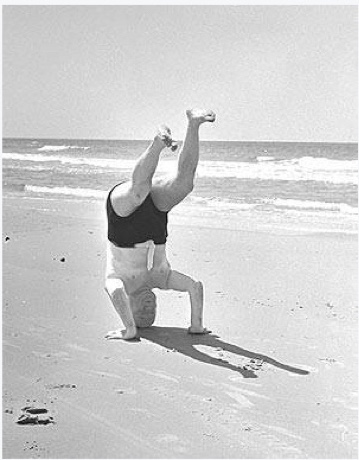The Introduction
Moshe Feldenkrais saw being able to balance on your head in a gradual and reversible manner as the ultimate test for our self-organisation, and it is something we explore very slowly in great many variations over several weeks in our training.
As most of you will never choose to do a whole training, the idea of this daily workshop is to break the process down into clear and simple steps so that you can explore the possibilities for yourself in digestible bites.
There is a paradox at the heart of Feldenkrais work, as some of the more challenging Awareness Through Movement sequences may be the most beneficial choices for the areas they challenge – as with all ‘remedies’ the effectiveness is based on the dosage, and in our method sometimes the movements are most effective in homeopathic doses.
The definition of “inversion” we will be exploring in this daily class is having the hips and the heart higher than the head, in relation to gravity. Experiencing your own weight as it rests on unfamiliar parts of yourself, and finding out how to move in a light, easy way despite the unusual positions you will find yourself in is a very effective process for both freeing up areas of tension within yourself, such as your neck, and shoulders, and for finding the sense of dynamic stability that emerges naturally as you learn to take the load off your soft tissues and make better use of your skeleton. This theme gives us lots of lovely Awareness Through Movement lessons to play with, and lots of fun moves to discover.
The Inspiration
In Israel Moshe Feldenkrais is famous for teaching David Ben Gurion to stand on his head, and we explored this posture in depth in my training, free from any pressure to succeed. Although I had some satisfying experiences with what were initially rather awkward positions, I never overcame my (undiagnosed) dyspraxia in order to be able to stand on my head. I did learn to balance easily on my head and hands, with my knees safely bent, so my centre of gravity was still nice and low. I greatly enjoyed these lessons – they enabled me to begin to release the long term tension I had been holding deep in my upper back, shoulder girdle and neck. My posture improved, my neck tension eased, I developed more freedom of movement in my shoulder girdle, and I felt rather pleased with myself. I particularly enjoyed the different kinds of rolling movements that developed out of this journey.
I had to give up my dance classes as my tendency to overdo it let to ever more injuries. Martha Graham Technique involves a lot of floor work so in some ways it was a great introduction to Feldenkrais, however it also encouraged my – already deeply embedded – tendency to push through any sense of physical resistance by increasing my effort, so these gentle backward and forward rolls were a delightful discovery, and a return to a kind of joyful whole self motion I thought I had lost. As a bonus, earning to move my whole self in this more integrated way began to undo much of the damage I had done to myself in the past.
The lessons that prepared us for the headstand were safe and enjoyable and ideal for anyone unlearning tension in these areas, or dealing with chronic issues such as headaches, neck and shoulder pain, and repetitive strain in upper limb joints – and of course, this being Feldenkrais, you are just as likely to discover greater ease in your hips and ankles too.
I think these Feldenkrais lessons are particularly useful for anyone with issues with their neck posture.We spend the vast majority of our waking hours sitting, standing or moving around in an upright stance and throughout the day our head remains balanced upright on the top of our spine without us having to think about it at all. The neck is a vital channel of communication for the whole of our nervous system, conducting millions of vital messages back and forth between our ‘brain-hub’ and all the extended branches of the nervous system, circulatory system, and the lymphatic system, throughout the whole self – naturally therefore our neck is very strong!Because of this important role, improving neck use affects the wellbeing of our whole self, and for the same reason improvements to the functioning of our neck and upper body can take a while to establish, however, once established everything you do will be easier, and chronic pain and daily physical effort will lessen naturally.
Bottoms Up!
Balancing & Rolling Upside-Down
Ways to improve the postural organisation of your head, neck & upper back
Jan 29th – Feb 2nd
Online + Recordings & Notes
2–3.30pm GMT ~ 9–10.30am EST ~ 6–7.30am PST* *Please note we start one hour earlier on Friday this time, due to an alteration in my regular schedule!
£90 (suggested fee, or any donation welcome)
…more workshop details…
This workshop will feature lessons designed to increase the flexibility of, and encourage more fluid movement in your upper spine, neck, shoulders and rib cage. We will use rotation, flexion, extension, and inversion to reawaken your natural elegance and poise.
Highly recommended for everyone, but particularly performers – musicians, singers, actors, dancers, martial artists – and anyone with issues related to the cranial functions, such as headaches, respiratory issues, balance issues etc.
